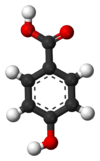4-Хидроксибензојева киселина
4-Hidroksibenzojeva kiselina je organsko jedinjenje, koje sadrži 7 atoma ugljenika i ima molekulsku masu od 138,121 Da.[3][4]
| |||
| Identifikacija | |||
|---|---|---|---|
3D model (Jmol)
|
|||
| ChEBI | |||
| DrugBank | |||
| ECHA InfoCard | 100.002.550 | ||
| |||
| Svojstva | |||
| C7H6O3 | |||
| Molarna masa | 138,121 | ||
Ukoliko nije drugačije napomenuto, podaci se odnose na standardno stanje materijala (na 25 °C [77 °F], 100 kPa). | |||
| Reference infokutije | |||
Osobine
уреди| Osobina | Vrednost |
|---|---|
| Broj akceptora vodonika | 3 |
| Broj donora vodonika | 2 |
| Broj rotacionih veza | 1 |
| Particioni koeficijent[5] (ALogP) | 1,2 |
| Rastvorljivost[6] (logS, log(mol/L)) | -1,1 |
| Polarna površina[7] (PSA, Å2) | 57,5 |
Reference
уреди- ^ Li Q, Cheng T, Wang Y, Bryant SH (2010). „PubChem as a public resource for drug discovery.”. Drug Discov Today. 15 (23-24): 1052—7. PMID 20970519. doi:10.1016/j.drudis.2010.10.003.
- ^ Evan E. Bolton; Yanli Wang; Paul A. Thiessen; Stephen H. Bryant (2008). „Chapter 12 PubChem: Integrated Platform of Small Molecules and Biological Activities”. Annual Reports in Computational Chemistry. 4: 217—241. doi:10.1016/S1574-1400(08)00012-1.
- ^ Knox C, Law V, Jewison T, Liu P, Ly S, Frolkis A, Pon A, Banco K, Mak C, Neveu V, Djoumbou Y, Eisner R, Guo AC, Wishart DS (2011). „DrugBank 3.0: a comprehensive resource for omics research on drugs”. Nucleic Acids Res. 39 (Database issue): D1035—41. PMC 3013709 . PMID 21059682. doi:10.1093/nar/gkq1126.
- ^ Nucleic Acids Res (2008). „DrugBank: a knowledgebase for drugs, drug actions and drug targets”. Nucleic acids research. 36 (Database issue): D901—6. PMC 2238889 . PMID 18048412. doi:10.1093/nar/gkm958.
|first2=захтева|last2=у Authors list (помоћ);|first3=захтева|last3=у Authors list (помоћ);|first4=захтева|last4=у Authors list (помоћ);|first5=захтева|last5=у Authors list (помоћ);|first6=захтева|last6=у Authors list (помоћ);|first7=захтева|last7=у Authors list (помоћ);|first8=захтева|last8=у Authors list (помоћ) - ^ Ghose, A.K., Viswanadhan V.N., and Wendoloski, J.J. (1998). „Prediction of Hydrophobic (Lipophilic) Properties of Small Organic Molecules Using Fragment Methods: An Analysis of AlogP and CLogP Methods”. J. Phys. Chem. A. 102: 3762—3772. doi:10.1021/jp980230o. Архивирано из оригинала 22. 07. 2014. г. Приступљено 13. 12. 2013.
- ^ Tetko IV, Tanchuk VY, Kasheva TN, Villa AE (2001). „Estimation of Aqueous Solubility of Chemical Compounds Using E-State Indices”. Chem Inf. Comput. Sci. 41: 1488—1493. PMID 11749573. doi:10.1021/ci000392t.
- ^ Ertl P.; Rohde B.; Selzer P. (2000). „Fast calculation of molecular polar surface area as a sum of fragment based contributions and its application to the prediction of drug transport properties”. J. Med. Chem. 43: 3714—3717. PMID 11020286. doi:10.1021/jm000942e.
Literatura
уреди- Clayden, Jonathan; Greeves, Nick; Warren, Stuart; Wothers, Peter (2001). Organic Chemistry (I изд.). Oxford University Press. ISBN 978-0-19-850346-0.
- Smith, Michael B.; March, Jerry (2007). Advanced Organic Chemistry: Reactions, Mechanisms, and Structure (6th изд.). New York: Wiley-Interscience. ISBN 0-471-72091-7.
- Katritzky A.R.; Pozharskii A.F. (2000). Handbook of Heterocyclic Chemistry (Second изд.). Academic Press. ISBN 0080429882.

